OPEN MENUCLOSE MENU
- Services
-
-
B2B Customer Experience
-
B2B Marketing
-
-
- Resources
- About Us
- Contact Us
The secret to great B2B Content Marketing is simple to say: use content to solve your prospects problems at each step of their Buyers Journey.
Of course simple to say doesn’t mean simple to do.
In this post I provide a step by step process that shows you exactly how to be successful.
First things first: B2B content marketing is the process of creating and distributing strategic content that helps move prospects along the Buyers Journey.
Content marketing is especially important for B2B organisations because
Let’s unpack those two items:
By its very nature the B2B sales process is long. These are big decisions which are carefully made.
To be successful you need to stay top of mind for the prospect during the whole process and, even more importantly, in the pre-decision parts of the Buyers Journey.
Content is a very effective way to educate and stay in touch with prospects long term.
For similar reasons, the buying team in a B2B sale is also large, up to a dozen or more people.
Content provides a very effective way for the entire prospect team to become familiar with your company.
Remember that great content marketing is solving your prospects problems at each step of their Buyers Journey.
So we need to identify those problems and then build, or reuse existing, content to solve them.
Before you can solve your prospects problems, you need to know who they are and the problems they face. Step 1 is documenting the Buyer Personas critical in your buying process.
You and/or your sales team will typically already know these personas at some level but make sure you push yourself to have real clarity in the personas you create.
Ensure the Personas you create are MECE (Mutually Exclusive and Comprehensively Exhaustive).
It’s very helpful to define personas from a “job they do” perspective, not a title perspective.
For example, if targeting small business owners, include all the titles they might choose: Shareholder, CEO, Director, Partner, etc.
Then research each persona in turn to understand them in detail. It’s key that you separate the facts from internal speculation. Often we think we know our prospects but are incorrect.
There are many ways to perform this research:
The most effective approaches in my experience are:
You should end up with a page of critical information on each persona.
In a B2B context, there is little need, in my opinion, to invent a full persona by including details such as how many children they have. Only put in details that help you understand their business perspective.
Here is an example to guide you:
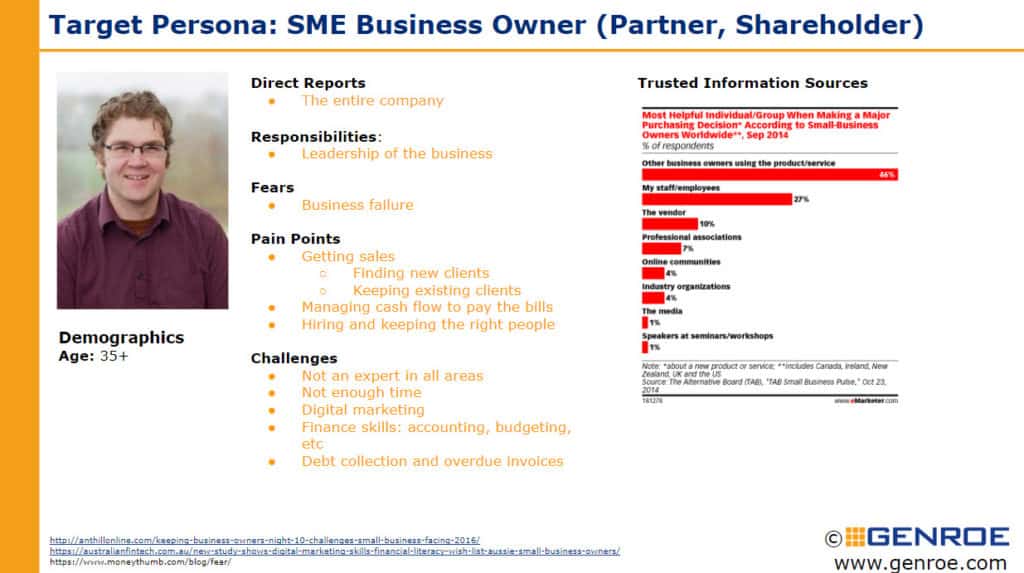
Also called B2B Content Marketing Funnels, Buyer Journeys are a critically important part of the process.
In every B2B purchase the customer solves three different types of problems (Journey steps):
Not every prospect consciously approaches the purchase in this way but every prospect solves all three problems before every purchase.
Identifying the problems at each step is critical in order to know the problems your content needs to solve.
Not that different marketers call the steps different things but they are essentially all the same:
For the rest of this post we will use the last column names for the Buyers Journey steps.
Here is a practical example of the Buyer Journey, albeit using a B2C task.
Let’s say you’re planning a trip to a new city by plane, your persona Buyer’s Journey problems might look like this:
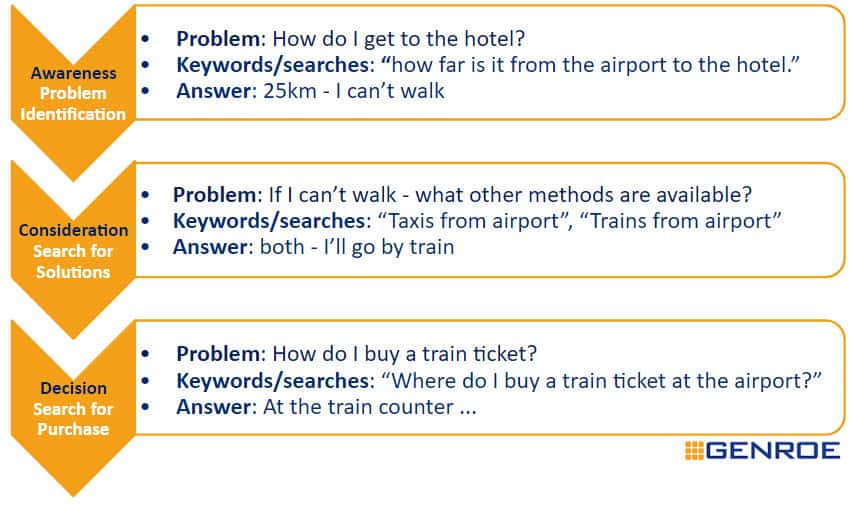
You can see now that as the problems change so too must our solutions, i.e. content. This is the start of identification of the keywords we would like to target.
Great sources for these problems will be the same research you used to generate the personas in the first place.
Now document these problems, by journey step and Persona:
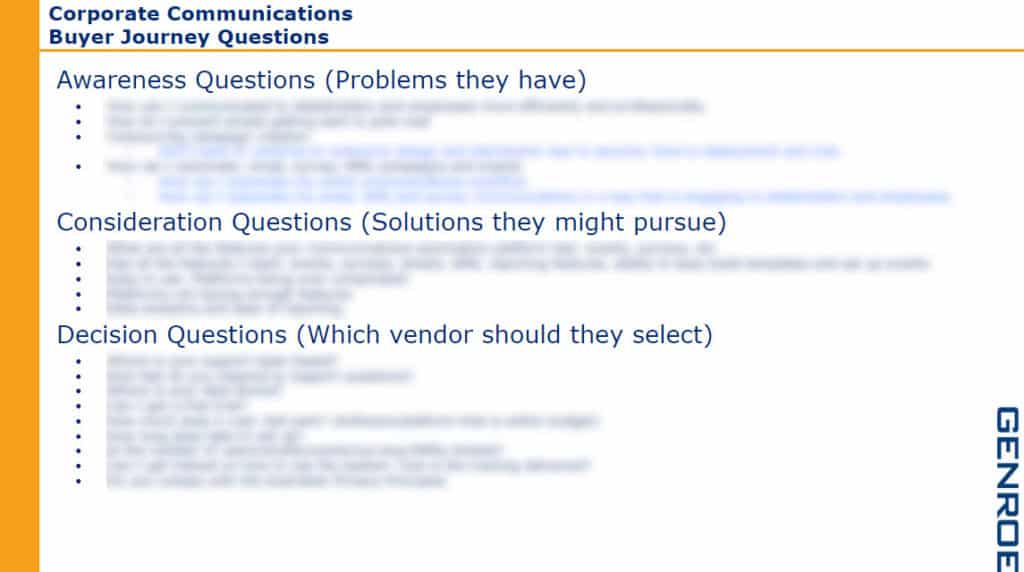
Now you understand the Buyer Personas and their problems, you need to know how the personas describe their problems; keyword analysis is a good approach to this task.
In keyword analysis you want to know:
There are lots of detailed keyword research guides so I won’t try to recreate them. Here are a couple of good ones:
The outcome from this step is a prioritized keyword plan with keywords for each Persona at each stage of the Buyer’s Journey.
Before we move on I will take a moment to discuss one critical element: Search Intent.
Search intent is understanding what question the searcher trying to answer when they enter keywords into a search engine.
Being good at Search Intent is critical for search engines – you could even say it’s their core deliverable. So they are very good at it and getting better all the time.
For example:
If I search “best thai restaurant“, Google knows the Search Intent is 99% likely to be “best thai restaurant near me” and provides results accordingly.
Your results will be different to mine, unless you live near me. 😁
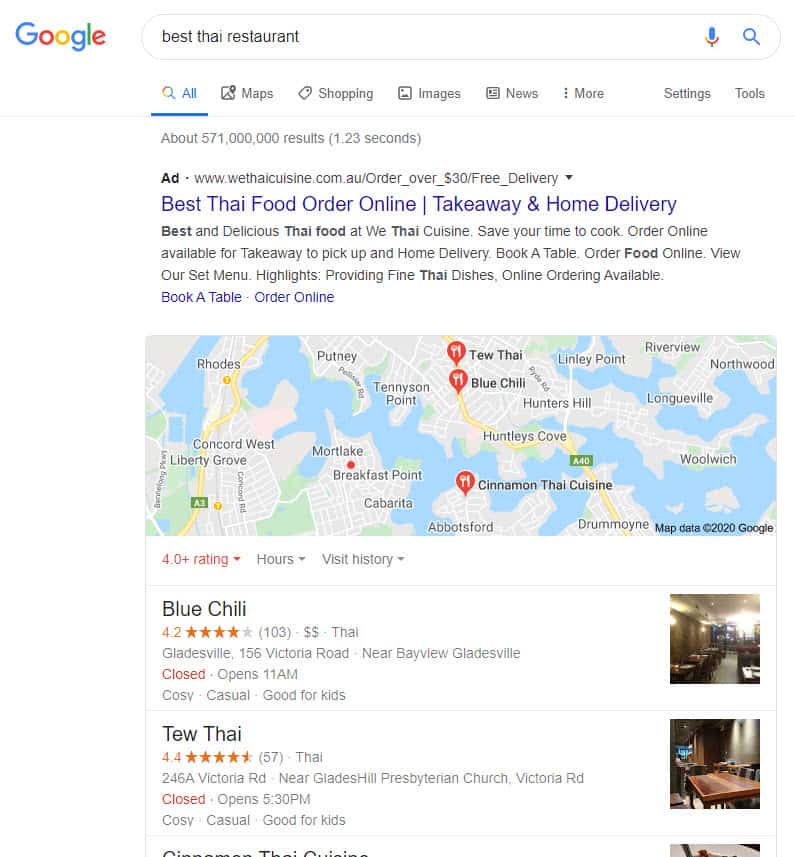
Matching content to Search Intent is critical because:
Sometimes Search Intent is relatively straightforward to determine.
If, for example, the keywords include:
The searcher is at the end of the Buyers Journey (Purchase stage) and search engines will return pages that offer the chance to purchase.
On the other hand if the search includes:
Search intent is near the middle of the journey (Search for Solutions) and content relevant to that intent will be surfaced by the search engines.
Unfortunately, it’s not always so clear cut.
In the end, the only way to really be sure of the search intent is to actually search using the keywords and see what is returned.
(Do this in an anonymous browser so your past search history does not skew the results.)
You should try every set of keywords in your list to validate the Search Intent.
In fact, when doing this I guarantee at least some of the results are not what you expect.
Warning: don’t be tempted to discard the results if the search intent indicated by the search engine doesn’t match your expectations. Google is not wrong.
And, even if Google is wrong (gasp), it is the reality to which you must adjust because that is what Google considers the search intent and so shows results accordingly.
In the end, don’t guess, just “search” all of your keyword phrases and confirm their Search Intent.
While we’re on keywords, the goal is not to be simply on page one of the Search Results pages.
Say what?!?
Yes, radical I know.
Just getting on page one for any old keyword feels successful, and you may even get some traffic but if it’s the wrong kind of persona or problem it’s worthless as they will not become customers.
The goal is to be on page one for relevant journey problems for relevant personas
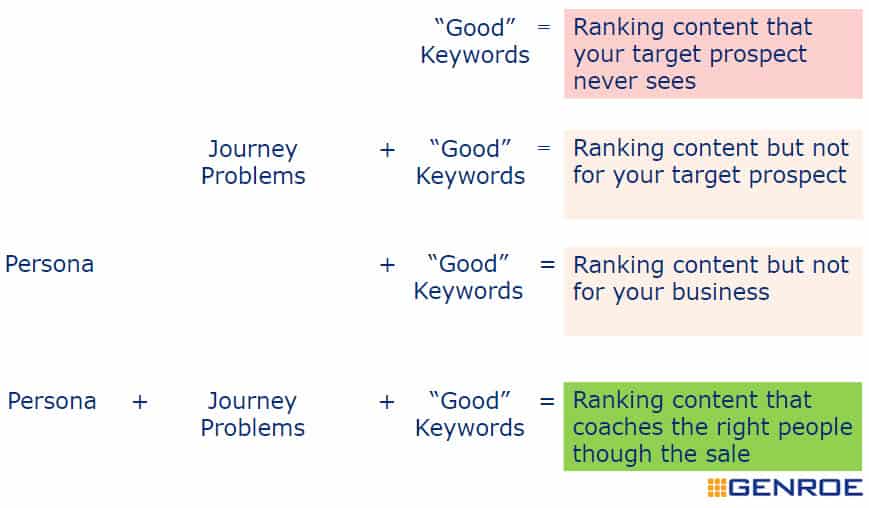
Now that you have clearly defined the Buyer Persona, Buyer Journey, Keywords and Content needs it’s time to audit your existing content to identify what exists and what needs to be created.
If you’ve been in business for any length of time you will have already created an expanse of content that you can likely can adapt and reuse.
Here is a checklist of places to look for applicable content:
Sales
Website
Marketing
As you collect the content, track it in a spreadsheet (or other tool) and allocate it by Persona and Buyers Journey stage.
This can be a lengthy process but it is necessary as it helps to identify overlaps and gaps in your content.
Here is how your finished audit should look.
Notice the the gaps? We’ll address those in the next step.
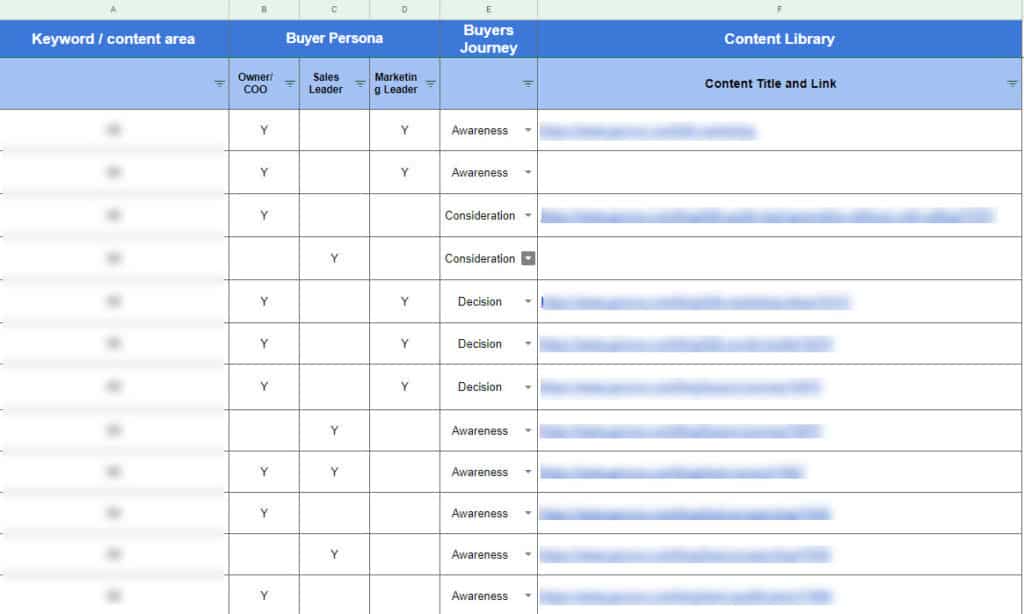
The content you create will change by Journey stage. Here are some examples of content types that target different stages of the Buyer’s Journey.
Now you need to plan how to do two things:
When creating new content don’t get confused between the content delivery mechanism and the content type.
For example: whitepapers, webinars, newsletters, social posts are all content delivery mechanisms.
On the the other hand: industry research, case studies, proposals, etc. are all content types that fill needs at each stage of the buyers journey.
Focus on getting the right content type and then worry about the content delivery mechanism later.
Re-purposing content is easier than creating new content and allows you to derive maximum value from it’s creation.
In re-purposing content you allow as many people as possible to interact with it
Here are a few great ways to repurpose your content:
But this is just a start, the opportunities are almost infinite.
Now you have a great set of content, targeted by Persona and Buyers Journey: the ways you can use it are almost endless.
Used in all of these ways it helps your company and staff become thought leaders and topic authorities. Greater authority means more trust and more trust leads to more sales.
Here are some suggestions.
Of course the first cab off the rank is taking your content and loading it to your website. After all, it’s custom tailored for attracting prospects because it’s targetted to their problems.
Remember search engines are just very sophisticated question and answer systems and you’ve got answers!
If your content is positioned on your website effectively, when prospects search for answers, your content will be high up in the search engine pages and attract prospects to your site.
Then they can interact with your business.
Create lead nurture flows that are Persona based. Not only will your unsubscribes be lower but click through rates will skyrocket.
Create snippets (by Persona and Journey Stage) in your CRM or favourite text expander and share them with your sales staff.They can then drop appropriate content into prospect emails quickly and easily.
Create libraries where the sales team can grab relevant content to put into presentations, emails and proposals.
As your content is deeply targeted by Persona and problem it is perfectly suited to being shared on social media by everyone in the company, not just marketing.
Creating advertising using the content is also very effective as it is deeply targeted to customer needs.

By: Adam Ramshaw
Updated: 20 Apr ’21